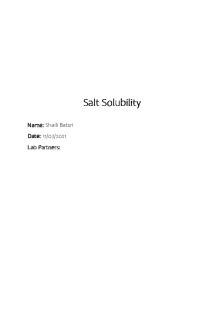Lab report #4Formula Mass of a Hydrated Salt PDF

| Title | Lab report #4Formula Mass of a Hydrated Salt |
|---|---|
| Author | Jennifer Arcila |
| Course | Introductory College Chemistry |
| Institution | Queensborough Community College |
| Pages | 2 |
| File Size | 96.1 KB |
| File Type | |
| Total Downloads | 33 |
| Total Views | 153 |
Summary
Download Lab report #4Formula Mass of a Hydrated Salt PDF
Description
Lab Report # 4 19/10/2020
Title: Formula Mass of a Hydrated Salt
Objective: Calculate the percentage by mass of water in cobalt sulfate
Introduction: There are certain compounds known as hydrates which trap water from the environment as part of their structure. Those compounds are salts and do so to become stable. An inorganic hydrate can release its water molecules, becoming anhydrous. The anhydrous form of the substance can absorb water, becoming hydrated. The water is known as the water of hydration or the water of crystallization. In the experiment, we are going to remove water from a compound given by heating it. The hydrate mass must be determined before, and after heating, then the percent of water in the compound can be found
Materials Used and Safety Precautions: Materials: Beaker Crucible tongs Equipment Top loading balance Heating plate
Methods/Procedures: First, the beaker was heated for about 5 minutes, making sure there was no water in it to avoid cracks. Second, the beaker was set in the balance, and its weight was measured and registered in the datasheet. Third, one gram of cobalt sulfate(powder) was poured into the beaker and then weight in the balance registering the datasheet data. Fourth, to dehydrate the compound, the beaker with the compound was initially "heated to constant mass" for 5 minutes. When checking on the weight to see the change after the dehydration and noticing no significant change, the compound was heated longer. After some minutes of heating the compound, the water's vapor ran out. Finally, it was weighed once again, and data was registered.
Results/Calculations: A. B. C. D. E. F. G. H.
Number and/or color of unknown hydrated salt: #4 cobalt sulfate brown Mass of beaker and cover: 85.5272 g Mass of beaker, cover, and hydrated salt before heating: 86.3125 g Mass of beaker, cover, and hydrated salt after heating After second 5 minutes of heating After third 5 minutes of heating (if necessary) After fourth 5 minutes of heating (if necessary): 85.9953 g Mass of hydrated salt (line C – B): 0.7853 g Mass of anhydrous salt (last line D – B): 0.4643 g Mass of water in hydrated salt (line E – F): 0.321 g Percent by mass of water in hydrated salt ((line G/E) *100): 40.88 %
Discussion/Conclusions: In the beginning, when heating the compound, we notice the change of color from brown to purple in its way to dehydrated. It can be explained that the loss of water molecules changes the compound's structure and properties. On the other hand, we realized that it is very important to heat the compound enough to ensure the water's vapor runs out completely, and the data been accurate. Significative changes in the mass of hydrated salt after heating are indicatives of successful dehydration.
Questions/Problems: 1. A student measured a 6.790 g sample of a hydrated salt. After heating, the mass of anhydrous salt was found to be 4.501 g. Use these data to calculate: a) The mass of water in the hydrated salt. 6.790 – 4.501= 2.289 The mass of water in the hydrated salt is 2.289 b) The percent by mass of water in the hydrated salt
(2.289/6.790) *100= 37.7% 37.7% is the percent by mass of water in the hydrated salt...
Similar Free PDFs

Percent Water in a Hydrated Salt
- 9 Pages

Salt Solubility - Lab Report
- 4 Pages
Popular Institutions
- Tinajero National High School - Annex
- Politeknik Caltex Riau
- Yokohama City University
- SGT University
- University of Al-Qadisiyah
- Divine Word College of Vigan
- Techniek College Rotterdam
- Universidade de Santiago
- Universiti Teknologi MARA Cawangan Johor Kampus Pasir Gudang
- Poltekkes Kemenkes Yogyakarta
- Baguio City National High School
- Colegio san marcos
- preparatoria uno
- Centro de Bachillerato Tecnológico Industrial y de Servicios No. 107
- Dalian Maritime University
- Quang Trung Secondary School
- Colegio Tecnológico en Informática
- Corporación Regional de Educación Superior
- Grupo CEDVA
- Dar Al Uloom University
- Centro de Estudios Preuniversitarios de la Universidad Nacional de Ingeniería
- 上智大学
- Aakash International School, Nuna Majara
- San Felipe Neri Catholic School
- Kang Chiao International School - New Taipei City
- Misamis Occidental National High School
- Institución Educativa Escuela Normal Juan Ladrilleros
- Kolehiyo ng Pantukan
- Batanes State College
- Instituto Continental
- Sekolah Menengah Kejuruan Kesehatan Kaltara (Tarakan)
- Colegio de La Inmaculada Concepcion - Cebu













